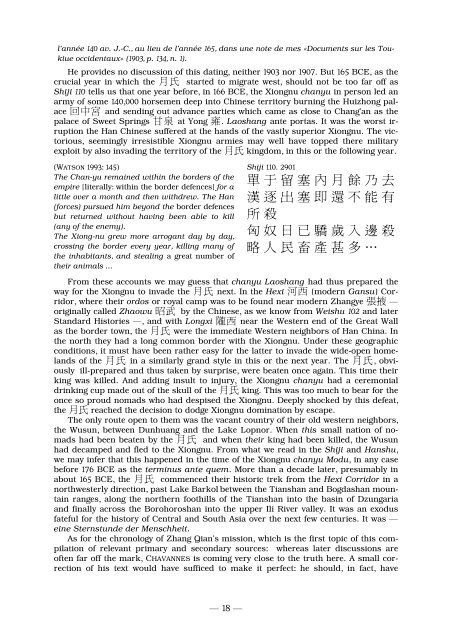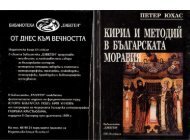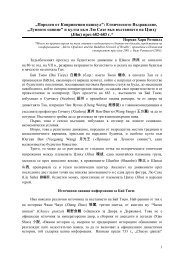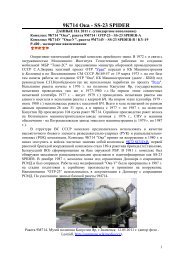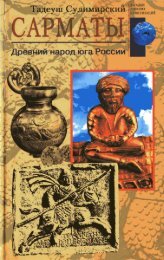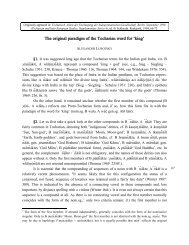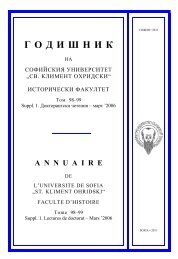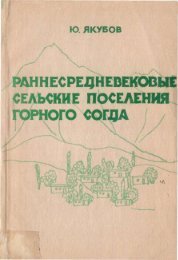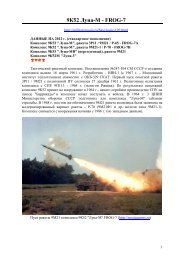You also want an ePaper? Increase the reach of your titles
YUMPU automatically turns print PDFs into web optimized ePapers that Google loves.
l’année<br />
140 av. J.-C., au lieu de l’année 165, dans une note de mes «Documents sur les Toukiue<br />
occidentaux» (1903, p. 134, n. 1).<br />
He provides no discussion of this dating, neither 1903 nor 1907. But 165 BCE, as the<br />
c rucial year in which the 月氏 started to migrate west, should not be too far off as<br />
S hiji 110 tells us that one year before, in 166 BCE, the Xiongnu chanyu in person led an<br />
army<br />
of some 140,000 horsemen deep into Chinese territory burning the Huizhong pal-<br />
a ce 回中宮 and sending out advance parties which came as close to Chang’an as the<br />
palace<br />
of Sweet Springs 甘泉 at Yong 雍. Laoshang ante portas. It was the worst irruption<br />
the Han Chinese suffered at the hands of the vastly superior Xiongnu. The victorious,<br />
seemingly irresistible Xiongnu armies may well have topped there military<br />
exploit by also invading the territory of the 月氏 kingdom, in this or the following year.<br />
(WATSON 1993: 145)<br />
The Chan-yu remained within the borders of the<br />
empire [literally: within the border defences] for a<br />
littl<br />
(forces) pursued him beyond the border defences<br />
but returned without having been able to kill<br />
(any of the enemy).<br />
The<br />
Xiong-nu grew more arrogant day by day,<br />
crossing the border<br />
every year, killing many of<br />
the inhabitants, and stealing a great number of<br />
their<br />
animals ...<br />
Shiji 110. 2901<br />
單 于 留 塞 內 月 餘 乃 去<br />
e over a month and then withdrew. The Han 漢 逐 出 塞 即 還 不 能 有<br />
所 殺<br />
匈 奴 日 已 驕 歲 入 邊 殺<br />
略 人 民 畜 產 甚 多 …<br />
From these accounts we may<br />
guess that chanyu Laoshang had thus prepared the<br />
way for the Xiongnu to invade the 月氏 next. In the Hexi 河西 (modern Gansu) Cor-<br />
ridor, where their ordos or royal<br />
camp was to be found near modern Zhangye 張掖 —<br />
originally<br />
called Zhaowu 昭武 by the Chinese, as we know from Weishu 102 and later<br />
Standard Histories —, and with Longxi 隴西 near the Western<br />
end of the Great Wall<br />
as the border town, the 月氏 were the immediate Western neighbors of Han China. In<br />
the north they had a long common border with the Xiongnu. Under these geographic<br />
conditions, it must have been rather easy for the latter to invade the wide-open homelands<br />
of the 月氏 in a similarly grand style in this or the next year. The 月氏, obviously<br />
ill-prepared and thus taken by surprise, were beaten once again. This time their<br />
king was killed. And adding insult to injury, the Xiongnu chanyu had a ceremonial<br />
drinking cup made out of the skull of the 月氏 king. This was too much to bear for the<br />
once so proud nomads who had despised the Xiongnu. Deeply shocked by this defeat,<br />
the 月氏 reached the decision to dodge Xiongnu domination by escape.<br />
The only route open to them was the vacant country of their old western neighbors,<br />
the Wusun, between Dunhuang and the Lake Lopnor. When this small nation of nomads<br />
had been beaten by the 月氏 and when their king had been killed, the Wusun<br />
had decamped and fled to the Xiongnu. From what we read in the Shiji and Hanshu,<br />
we may infer that this happened in the time of the Xiongnu chanyu Modu, in any case<br />
before 176 BCE as the terminus ante quem. More than a decade later, presumably in<br />
about 165 BCE, the 月氏 commenced their historic trek from the Hexi Corridor in a<br />
northwesterly direction, past Lake Barkol between the Tianshan and Bogdashan mountain<br />
ranges, along the northern foothills of the Tianshan into the basin of Dzungaria<br />
and finally across the Borohoroshan into the upper Ili River valley. It was an exodus<br />
fateful for the history of Central and South Asia over the next few centuries. It was —<br />
eine Sternstunde der Menschheit.<br />
As for the chronology of Zhang Qian’s mission,<br />
which is the first topic of this compila<br />
tion of relevant primary and secondary sources: whereas later discussions are<br />
often<br />
far off the mark, CHAVANNES is coming very close to the truth here. A small cor-<br />
rection<br />
of his text would have sufficed to make it perfect: he should, in fact, have<br />
— 18 —


